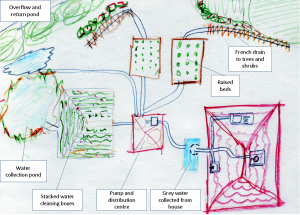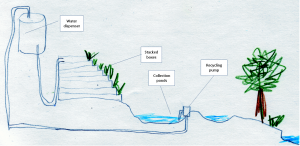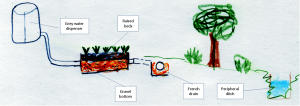What follows is the tapescript of an imagestreaming session aimed at furthering my understanding of grey water purification. This is session two. I have chosen to use the technique of imagestreaming rather than just searching the Internet as I find it provides me with deeper insights, and that it offers more innovative solutions.
Last time, I learned how to make a water cleaning installation using vegetable growing boxes stacked together to form an arrangement rather like a water feature. Although I can say the imagestream took me some way to understanding grey water purification, it also raised a whole string of questions. One major concern was that I saw no way to actually recycle the water once cleaned. Neither did I get an idea of how to collect grey water for redistribution through this feature.
The Quest; to visit a place that uses single-house grey water systems; they grow vegetables in the installation, in a climate like ours that freezes. I need to see how they collect the grey water and what happens to it. This place should have more water fall down as rain than they use. One of the reasons for doing this is to be able to make a proposal for the eco-unit. I feel it would be a good thing to be able to implement a one-dwelling solution as an experiment.
I close my eyes and am instantly in the waiting area I visited last time. The facilitator is beside me. He tells me I should write a book about facilitating. I nod without committing myself.
He says, “That last place was wishful thinking…a sales exhibition. The city of Porena solved grey water recycling, come back there with me.”
“OK,” I agree, and off we walk to the train station.
On the train, going through a tunnel I study his clothes and notice he has gardening boots on.
He reads my thoughts; “There’s always gardening to do!”
We leave the train at the relocalisation centre. This is an information center I met earlier, housing exhibitions and training centres to help individuals and communities relocalize their living arrangements to address climate change and fossil fuel depletion as well as to create sustainable communities. As we pass the reception the receptionist, dressed in Swedish national dress, curtsies.
The facilitator leans over and says in a low voice, “You need to go to a demo house – where they show every pipe and connection so you don’t need to rip floors up to understand the way it works.”
We walk over to the demo house and I see what he means. All the pipes are visible. I ponder that showing pipes and the way things are constructed might be part of sustainability, but can’t really explain why. I start at the sink and look under it, tracing the pipe to a three way valve located just inside the outer wall. The shower upstairs connects into it.
For demonstration purposes they have a village solution and an individual house solution.

Schematic view from above
In one position of three way valve, the grey water flows to the individual water cleaning solution, and in the other to the communal system. I follow the individual solution pipe to just outside the house.
The pipe leads into an underground storage tank, where the water first pours through a plastic net basket that collects the worst grunge. You need to empty it once a fortnight. The tank is concrete, far enough under ground to keep it away from frost. And if it froze it would overflow anyway and not cause too much damage.
The facilitator told me to work out the water consumption that would flow through this installation. He also pointed out you want the water to turn over in the pit and not to stay around. Anyway, keeping the water away from the house is important.
Close by is a small shed, where the water is pumped up into a plastic tank. A float valve arrangement keeps the water at a certain height and pressure.
“You need some central control point,” the facilitator points out.
This house feeds the whole garden. All grey water flows out from the back of the shed via pipes to where it is needed. One pipe goes to the stepped boxes, another branches off to other parts of the garden. These boxes form a three-sided pyramid. Grey water is pumped onto the top box; from there it slowly trickles through all boxes, being cleaned by the roots of the plants. At the bottom the water collects into a pond.

Side view of growing box solution
The water in this pond overflows through a sand bed into the rest of the garden. Finally, any excess water ends up in a ditch that goes round the periphery of the property. As vegetables need a steady flow of water, the cleaned water is pumped back to mix with grey water. The collecting tank in the distribution shed has two compartments. The water trickles out from the tank. When it is empty the pumps start again to fill it. A sensor at the bottom of the tank senses it is empty and starts the pump. You could run the whole thing from solar cells that charge the battery and run the pump.

Side view of vegetable patch and tree and shrub solution
The other pipe takes the grey water going to the vegetable patch. It is discharged into a layer of gravel under about six inches of soil. The slope is designed to be 4 percent. The roots of the plants grow downwards onto the gravel and pick up all the nutrients they need form the grey water, cleaning it at the same time.
Water leaving the vegetable patches flows to the trees, shrubs and ornamental plants. The growing beds drain out on the highest point on a slope above the shrubs. It ends in a kind of French drain on contour, or rather like a half of a French drain. Water flows out into gravel in a trench, the side facing the upper slope beings covered with waterproof sheeting, This ensures the water diffuses down the slope.
I also note that the source of the water coming from the house is mostly rainwater. This puzzles me as I cannot see how enough rain falls on roofs to satisfy the needs of the average household. I need to calculate theoretical yields and come back with my questions. The sensible thing would be to collect rain water, and also send cleaned water from the garden feature back to the house. More of that for next time.
Things that surprised me.
I was surprised that a small shed was needed to distribute the water. I guess you could combine it with a garden tools shed. But I understand the importance of keeping it from freezing. The dispensing arrangement surprised me, I still have not worked out how it works. I was also pleasantly surprised by the simplicity of the arrangement.
Things to try immediately.
I could try to make a garden feature from cast concrete boxes with drainage holes.
Questions to research more.
How much water actually falls as rainwater, and can you use it without purifying it somehow? How to collect rainwater and recycle it back to the house. Maybe I need to understand a little better how to make concrete growing boxes. And I must work out how this plastic dispenser tank works, it seems to have two compartments and sensors and to be the control room of the whole set-up.
1 thought on “Grey water imagestream #2”